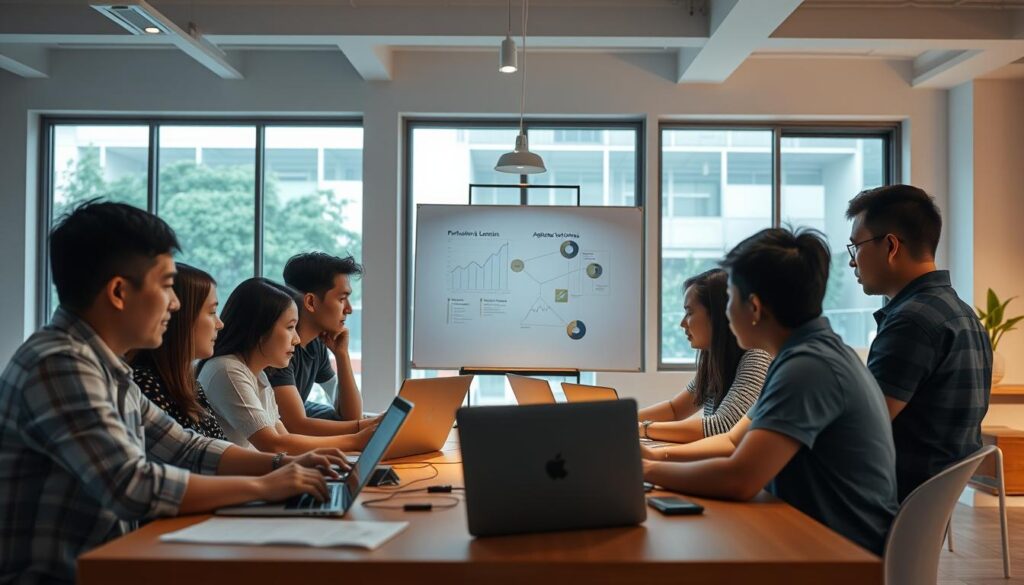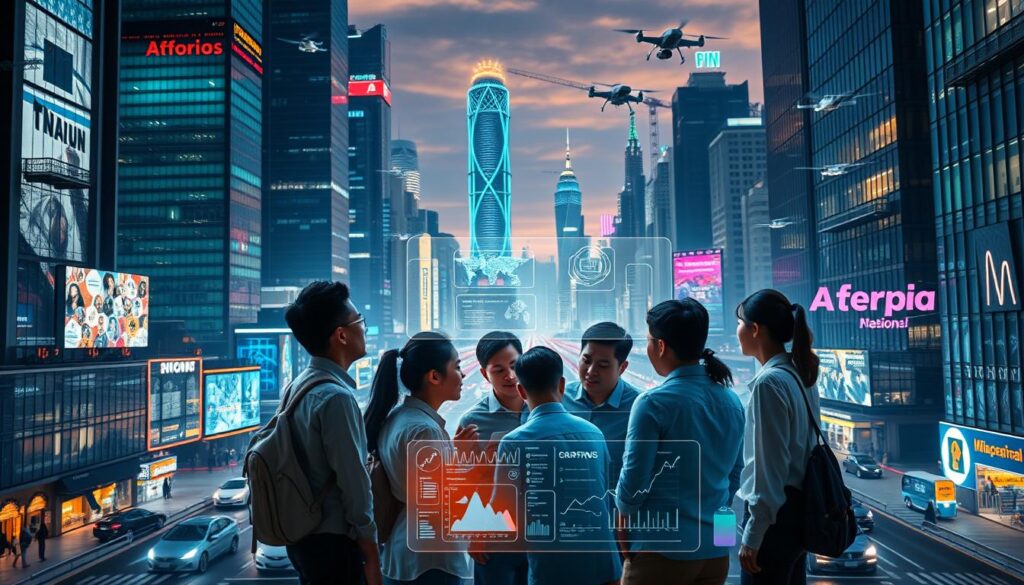Ever wondered how some companies keep their employees engaged and growing fast? The secret might be in adaptive learning platforms. These tools use AI to tailor learning to each person’s needs. In the Philippines and Southeast Asia, more companies see their value in building a skilled team.
Adaptive learning changes how we train. It makes learning more personal and effective. This is key for improving our workforce.
Key Takeaways
- Adaptive learning platforms offer customized training experiences for employees.
- AI adaptive learning enhances personalization, leading to improved engagement.
- These tools are essential for organizations aiming to foster continuous employee growth.
- Data-driven insights from adaptive learning platforms can inform learning strategies.
- Companies in Southeast Asia are successfully implementing adaptive learning solutions.
Understanding Adaptive Learning Platforms
Adaptable learning platforms change how we learn. They use personalized methods that fit each learner’s needs. This is different from old ways of learning, which were the same for everyone.
These new platforms use technology to make learning paths for each student. They help bridge the gap between what students can do and what they’re taught. This changes how we get educational content.
Definition of Adaptive Learning
Adaptive learning changes what you learn based on how you do. It uses AI to see what you know and what you don’t. This makes learning more focused on you.
This is different from old ways of learning. Old ways don’t change much. But adaptive learning keeps changing to fit you better.
How Adaptive Learning Differs from Traditional Learning
Adaptive learning is more engaging and efficient than old ways. Old ways use the same materials for everyone. But adaptive learning changes based on what you need.
It gives feedback right away. This makes you more interested and helps you remember better. It makes training for employees more effective.
Companies can use technology to train employees better. For more on using AI in training, check out this link.
Benefits of Adaptive Learning for Employee Growth
Adaptive learning platforms are changing how we train employees. They offer customized learning experiences that boost skills and knowledge. These systems use data to understand each employee’s learning style, making training more effective.
By matching training to individual needs, these platforms improve engagement and keep employees longer. This approach helps employees grow and feel valued in their roles.
Enhanced Personalization Through AI
Adaptive learning uses AI to get to know employees’ strengths and weaknesses. It tracks their progress and suggests learning paths that fit their style. This makes employees feel more connected to their growth.
Increased Engagement and Retention Rates
Companies that use adaptive learning see big gains in employee engagement and retention. Customized training makes learning more relevant and satisfying. This leads to happier employees who are more committed to their work.

Key Features of Adaptive Learning Platforms
Adaptive learning platforms have key features that make learning better. They help learners work more efficiently and stay engaged. Features like real-time feedback, personalized learning paths, and data insights make these platforms stand out in corporate training.
Real-Time Feedback Mechanisms
Real-time feedback is a key feature of adaptive learning. It lets learners know how they’re doing right away. This helps them see where they need to improve and adjust their learning.
Getting feedback quickly helps learners grasp new ideas better. It boosts their learning results.
Individualized Learning Paths
Adaptive learning platforms offer personalized learning paths. They adjust to each learner’s pace and needs. This keeps learners interested and helps them understand the material better.
By tailoring learning, businesses can help their employees reach their full potential.
Data-Driven Insights for L&D Teams
Data insights are vital for L&D teams. They show what employees are good at and where they need work. This helps teams improve their training plans.
Using data from adaptive learning platforms helps focus on important skills. It ensures training meets both company goals and learner needs.
Top Adaptive Learning Platforms for Corporations
Finding the right adaptive learning platform is key for companies wanting to improve their training. Many look for top platforms that focus on corporate learning. This section highlights notable platforms like Whatfix, EdApp, and Realizeit, focusing on their strengths and unique features. A detailed comparison will help find the best fit for your organization’s goals.
Overview of Leading Solutions
Whatfix is great for companies wanting to simplify their learning efforts. It has easy-to-use interfaces and integrates well with other tools. EdApp is perfect for those who want to engage employees through mobile learning and games. Realizeit is known for its advanced analytics, helping managers create personalized learning paths.
Comparison of Features
| Platform | Main Features | Pricing Model |
|---|---|---|
| Whatfix | Integration with other tools, customizable learning paths | Subscription-based, varies by features |
| EdApp | Mobile compatibility, gamification, templates library | Free and paid models available |
| Realizeit | Advanced analytics, personalized learning experiences | Tiered pricing structure depending on user count |

Comparing these features helps companies in the Philippines choose wisely. They can pick the best platform for their learning needs and growth plans.
AI Adaptive Learning: The Future of Employee Development
AI is changing how companies train their employees. It lets them create learning plans that fit each person’s needs. This approach is a big step forward in employee development.
Integrating AI into Learning Programs
More companies are using AI to improve their training. They use smart algorithms to make learning plans that fit each person. This way, everyone learns better and understands more.
Examples of AI Impact on Learning Effectiveness
Big companies are seeing how AI helps their training. For example, Moodle and Coursera use AI to suggest learning materials. This makes learning more engaging and helps people remember what they learn.
Performance Management & Engagement
Adaptive learning changes how employees grow and succeed. It uses real-time feedback to make learning more personal. This makes work better and keeps employees interested.
When training fits each person’s needs, it feels like a chance to grow. It’s not just something they have to do.
Role of Adaptive Learning in Performance Management
Adaptive learning is key in improving how we manage work. It looks at how each person does and changes learning plans. This means everyone gets the right training to get better.
Teams start to do better, and the whole company succeeds more. It’s a win-win for everyone.
Enhancing Employee Engagement through Tailored Learning Experiences
Learning that fits each person makes work more fun. Adaptive learning does this by offering choices that match what each person likes. This makes workers more excited to learn and grow.
Companies that use adaptive learning keep their best workers. They build a loyal team in the competitive job market of the Philippines.

Considerations for Choosing an Adaptive Learning Platform
Choosing the right adaptive learning platforms is a big decision. You need to think about the cost and how easy the software is to use. These factors are key to the success of your training program.
Budget and Pricing Models
Cost is a big factor when picking adaptive learning platforms. Look at the different pricing options, like monthly subscriptions or one-time fees. Also, consider the total cost over time, including any extra fees. Knowing these costs helps you make a choice that fits your budget.
User-Friendliness and Support
A user-friendly software makes it easy for everyone to get started. It should be simple for both users and admins to use. Good technical support is also important. It helps users solve problems quickly, making everyone happier with the system.
| Consideration | Aspects to Evaluate |
|---|---|
| Budget | Pricing models, total cost of ownership, and potential hidden costs. |
| User-Friendliness | Intuitive interface, ease of navigation, and accessibility options. |
| Support | Technical assistance, response time, and availability of resources. |
Success Stories: Asian Companies Utilizing Adaptive Learning
Adaptive learning platforms have greatly helped Asian companies improve their employee training. They have seen big changes in many areas. In the Philippines, companies have seen big wins with adaptive learning, improving skills and keeping employees happy.
Here are two examples of how adaptive learning has changed employee training for the better.
Case Study: Company A in the Philippines
Company A in the Philippines used an adaptive learning platform to better their training. They made learning personal for each employee, no matter their skill level. They tracked how well employees were doing and changed what they learned to keep them interested.
This made employees happier and more likely to stay with the company. It shows how adaptive learning can help businesses grow and succeed.
How Company B Transformed Employee Training in Southeast Asia
Company B works in many Southeast Asian countries. They used adaptive learning to make sure their employees had the right skills for the job. They made learning personal for each employee, helping them do their best work.
They used data to make sure each employee got the right training. This made employees more effective and helped the company stay ahead. It shows how adaptive learning can help businesses succeed in a changing world.
Challenges and Limitations of Adaptive Learning Platforms
Adaptive learning platforms come with their own set of challenges and limitations. These can affect how well they work and the learning experience for employees.
Implementation Challenges
Several implementation issues can make it hard to start using adaptive learning systems. One big problem is resistance to change in organizations. Employees and managers might not want to try new ways of learning, even if they’re better.
Another issue is making sure these systems work well with what you already have. It’s important to keep the learning experience smooth. Also, keeping the content fresh and relevant is a big job, needing a lot of time and effort.
Data Privacy Concerns
Keeping data privacy in learning systems is also a big deal. It’s important to balance making learning personal with keeping information safe. This is even more true in places with strict data protection laws, like Southeast Asia.
Following local data protection laws is key to avoiding problems and making sure learners feel safe. Overcoming these hurdles is crucial for getting the most out of adaptive learning in the workplace.
Future Trends in Adaptive Learning Technologies
New technologies are changing how we learn. Companies are using new tools to make learning better. This includes virtual reality and games, making learning fun and interactive.
These tools help make learning fit each person’s needs. This means everyone can learn in a way that works best for them.
Emerging Technologies to Watch
There are a few new technologies that will change learning:
- Virtual Reality (VR): VR lets people learn by doing things in a fake world. It’s great for practicing skills.
- Artificial Intelligence (AI): AI makes learning personal. It looks at what you know and changes what you learn to fit you better.
- Gamification: Adding game-like things to learning makes it more fun. This makes learning more effective.
Potential Impact on Remote Learning and Hybrid Workforces
These new trends will help remote learning a lot. As more people work from home, learning tools need to adapt. They must work for everyone, no matter where they are.
These tools help everyone learn well, whether they’re in the office or at home. Companies need to use these tools to help their workers grow. This way, they can keep up with changing work needs.

Conclusion
Adaptive learning platforms are key for employee growth and engagement. They use advanced technology for personalized training. This is crucial in Southeast Asia, where markets change fast.
Adaptive learning tailors training to fit each employee’s needs. This leads to better performance and job happiness. It makes workforces agile and ready for today’s business world.
Choosing adaptive learning is more than a trend. It’s a way to build a strong and ready workforce. By focusing on personal learning, companies can create a team that keeps growing and staying engaged.

